Purpose
The purpose of this activity is to support students in understanding that the digits in a three-digit whole number refer to different sized units that can be subtracted, just like units of one.
Achievement Objectives
NA2-1: Use simple additive strategies with whole numbers and fractions.
Required Resource Materials
- Place Value People (a paper representation of hundreds, tens, and ones to be used by students)
- Scissors
- Calculators
- Three-column place value boards
Activity
- Pose initial problems in which tens, and then hundreds, are subtracted. Use the context from the diagnostic question (or alter this to better reflect the interests and backgrounds of your class) and alter the numbers.
There are 80 people at the netball game. 40 people leave early.
How many people are left at the game?
- Model the problem with Place Value People on a Place Value Board.
How many tens make eighty?
Forty people leave. How many tens is that?
How many people are in the town now?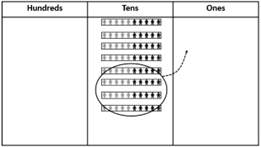
- Record the calculations modelled using an algorithm and an equation.
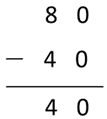 80 - 40 = 40
80 - 40 = 40
What do you notice?
Look for students to apply their understanding of 8 - 4 = 4 to solve 80 - 40 = 40. You might emphasise this by modelling the subtraction of 4 from 8, using the place value people in the ones column of the place value board, before drawing attention to the similarities between this model, and a model of 80 - 40.
Use a calculator to model the sequence of pressing keys and to confirm the result.
- Provide other problems, altering the context as appropriate. Model each problem with materials (place value people and the three-column place value board), calculator sequences, equations, and a vertical written algorithm, as appropriate to the needs of your students.
Subtracting tens without renaming
- There are 70 people at the netball game. 60 people leave early.
How many people are left at the game? - Avoid renaming at this point.
Subtracting hundreds without renaming
- There are 600 people at the netball game. 400 people leave early.
How many people are left at the game?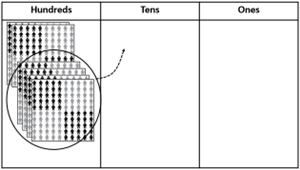
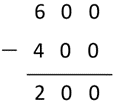 600 - 400 = 200
600 - 400 = 200
- Look for students to apply their understanding of 6 - 4 = 2 to solve 600 - 400 = 200.
Subtracting hundreds and tens without renaming
- There are 530 people at the netball game. 200 people leave early.
How many people are left at the game?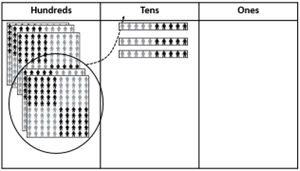
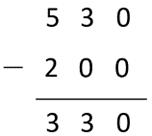 530 - 200 = 330
530 - 200 = 330
- Look for students to recognise that 5 - 2 = 3 can be applied to solve 500 - 200 = 300, just like 3 - 0 = 3 can be applied to solve 30 - 0 = 30. Students should also recognise the role of zero as both a place holder and a symbol for “nothing of something”.
- Vary the numbers given in the subtraction problems to support students to act on units of one hundred and ten, just as they acted on units of one. Examples might be:
- There are 670 people at the netball game. 50 people leave early.
How many people are left at the game? - There are 490 people at the netball game. 240 people leave early.
How many people are left at the game?
Next steps
- Practise the three key connections between words, numerals and quantities until students are fluent in solving problems without materials. This should involve the efficient use of algorithms and equations to solve problems. You might model the use of materials for the students as they solve the problem or support some students to "fold back" to the use of materials to check their working. Reinforce understanding with the use of calculator sequences. For example:
There are 980 people at the netball game. 530 people leave early.
How many people are left at the game?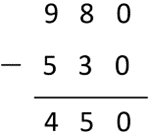 980 - 530 = 450
980 - 530 = 450
- Pose problems that involve ones as well as tens and hundreds, with no renaming. For example:
There are 764 people at the netball game. 250 people leave early.
How many people are left at the game?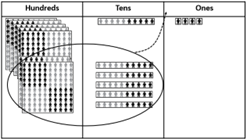
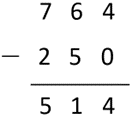 764 - 250 = 514
764 - 250 = 514
Add to plan
Level Two